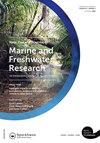聚类分析揭示了与新西兰奥特亚奥塔哥蓝皮湾河口管理相关的利益相关者利益的潜在结构
IF 1.7
4区 环境科学与生态学
Q3 FISHERIES
New Zealand Journal of Marine and Freshwater Research
Pub Date : 2022-07-03
DOI:10.1080/00288330.2022.2103159
引用次数: 1
摘要
摘要社区参与越来越多地融入环境政策,目的是加速向可持续管理转变。与社区接触的一种常见方法是通过关键利益相关者,他们仍然经常根据自己的活动进行临时选择。我们测试了一种分析方法,以确定不同的社区偏好群体,作为案例研究的一部分,为蓝皮湾河口及其集水区制定社区主导的管理计划。我们采访了36名社区成员,以了解他们对遵循标准化协议的预定义管理目标的偏好。通过聚集层次分析,我们确定了高层管理目标和更具体目标的价值偏好集群。在这两个层面上,偏好集群都归因于一些商业利益,如公鸡收割、林业或旅游业,我们也根据它们在蓝皮湾地区的活动临时确定了这些利益。然而,除此之外,聚类分析还揭示了五种额外的偏好类型:城市发展倡导者、文化环保主义者、经济环境主义者、综合思想家和兴趣多样化者。我们得出的结论是,聚类分析更客观、更具体地映射了社区偏好,从而提高了协作环境管理过程的稳健性,例如正在进行的蓝皮湾河口环境管理过程。本文章由计算机程序翻译,如有差异,请以英文原文为准。
Cluster analysis reveals latent structure in stakeholder interests relevant to the management of Blueskin Bay estuary, Otago, Aotearoa New Zealand
ABSTRACT Community participation is increasingly embedded into environmental policy with the aim of accelerating transformative change towards sustainable management. A common approach to engaging with communities is through key stakeholders, who are still often selected ad hoc based on their activities. We tested an analytical approach for identifying distinct groups of community preferences as part of a case study to develop a community-led management plan for Blueskin Bay estuary and its catchment. We interviewed 36 community members to elicit their preferences for predefined management objectives following a standardised protocol. Using an agglomerative hierarchical analysis, we determined value-preference clusters for high-level management objectives and more specific objectives. At both levels combined, preference clusters were attributed to some of the commercial interests, such as cockle harvesting, forestry or tourism, which we also identified ad hoc based on their activities in the Blueskin Bay area. However, in addition, cluster analyses revealed five additional preference types: Urban Development Advocates, Cultural Environmentalists, Economic Environmentalists, Integrative Thinkers and those with Diverse Interests. We conclude that cluster analysis more objectively and specifically maps community preferences and, consequently, increases the robustness of collaborative environmental management processes, such as the one underway for Blueskin Bay estuary.
求助全文
通过发布文献求助,成功后即可免费获取论文全文。
去求助
来源期刊
CiteScore
4.50
自引率
12.50%
发文量
35
审稿时长
3 months
期刊介绍:
Aims: The diversity of aquatic environments in the southern continents and oceans is of worldwide interest to researchers and resource managers in research institutions, museums, and other centres. The New Zealand Journal of Marine and Freshwater Research plays an important role in disseminating information on observational, experimental, theoretical and numerical research on the marine, estuarine and freshwater environments of the region.

 求助内容:
求助内容: 应助结果提醒方式:
应助结果提醒方式:


